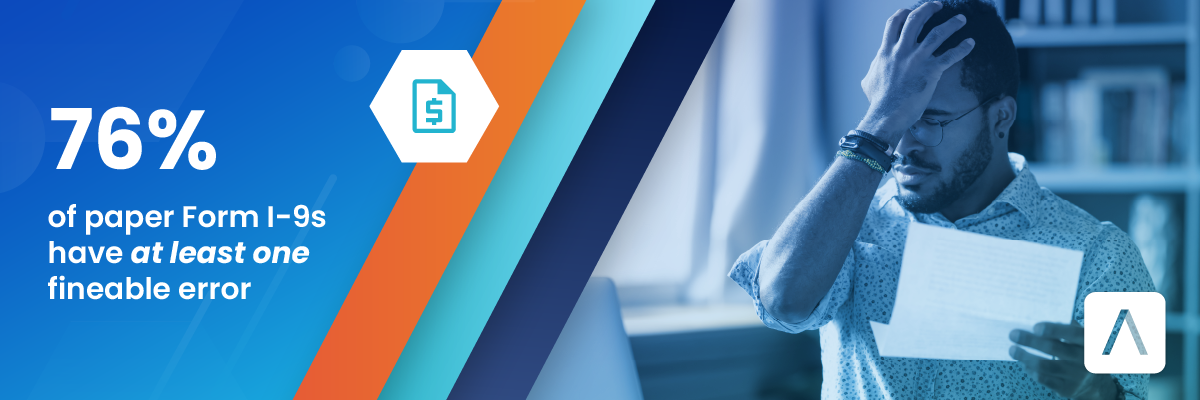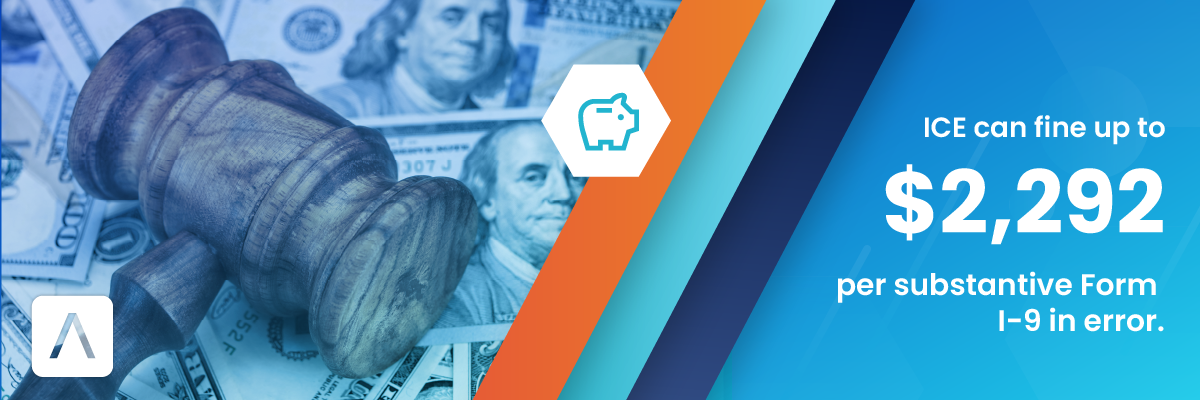While Form I-9 isn’t new, it is something that every employer needs to be aware of and monitor. Unfortunately, many employers and employees may be unaware of this critical document’s significance in hiring and compliance.
In this complete guide to Form I-9, learn the purpose of this form for organizations, explore best practices for compliance and preventing risk, understand common errors to avoid, and even delve into how it applies to remote workers.
What is an I-9 Form?
What exactly is Form I-9? Simply put, it’s an employment eligibility verification form that employers and newly hired employees must complete.
The purpose of Form I-9 is to establish an individual’s identity and work authorization within the country. It ensures compliance with federal immigration laws and helps prevent unlawful hiring practices. By completing this form, employers verify that their employees are legally eligible to work in the United States.
How does I-9 completion work?
When new employees join a company, they must fill out Section 1 of Form I-9 on or before their first day of employment. This section requests personal information such as:
- Name
- Address
- Date of birth
- Social Security number
- Citizenship status
Once the employee fills out Section 1, it’s up to the employer or an authorized representative to complete Section 2 within three business days of the employee’s start date. The employer must physically examine documents proving identity and work authorization in this section.
It’s important to note that certain documents are acceptable for establishing identity, while others are accepted for proof of work authorization. The list provided on Form I-9 outlines which documents can be presented during this verification process. You should have this list handy to ensure you’re doing things correctly – or you risk a fine.
Failure to comply with Form I-9 requirements can result in severe penalties for employers, including fines and even criminal charges in extreme cases. Additionally, non-compliance can negatively impact an employee’s ability to maintain legal working status or potentially lead to termination if proper documentation cannot be provided.
You can learn more about the history of Form I-9 and some practical examples of its use here.
Who is Responsible for Compliance with Form I-9?
One of the critical aspects of maintaining compliance with Form I-9 is understanding who is responsible for ensuring its proper completion. In general, both employers and employees have specific obligations when it comes to Form I-9. Accountability may vary from organization to organization, so knowing who is tracking is essential.
In most organizations, employers and Human Resources are primarily responsible for overseeing the entire process. This includes providing employees with the necessary forms, verifying identity and employment authorization documents, and reviewing them for authenticity. Employers must also ensure that each employee completes Section 1 of Form I-9 accurately by their first day of work.
Employees also have a crucial role in this process. They must complete Section 1 truthfully and provide all required information within three business days from their start date. Employees should also present acceptable documents to establish identity and employment authorization to their employer.
Employers must communicate clearly with their workforce regarding Form I-9 requirements and deadlines. Both parties need to understand their responsibilities to maintain compliance and avoid potential penalties or legal issues. The onus is on Human Resources leaders here to get it right – and it’s a lot of responsibility.

Form I-9 Best Practices
When managing Form I-9 compliance, several best practices can help ensure accuracy and avoid potential penalties. Some key tips to keep in mind:
 Train HR Staff
Train HR Staff
It is crucial to provide proper training to your HR team on how to complete and verify Form I-9 correctly. This will help them understand the requirements and avoid common errors.
 Establish a consistent Form I-9 process
Establish a consistent Form I-9 process
Create a standardized process for completing Form I-9 for all new hires. A straightforward step-by-step procedure will help minimize mistakes and ensure consistency across the board.
 Stay up-to-date with regulations
Stay up-to-date with regulations
Immigration laws are subject to change, so staying informed about any updates or revisions related to Form I-9 compliance is essential.
 Conduct regular internal audits
Conduct regular internal audits
Review your company’s completed Form I-9s for accuracy and completeness on a routine basis. This proactive approach lets you identify potential issues before they become problematic during an external audit or inspection.
 Retain records securely
Retain records securely
Keep all completed Forms I-9 in a secure location as required by law, maintaining confidentiality while ensuring easy accessibility during inspections or audits.
 Utilize electronic systems
Utilize electronic systems
Consider using electronic platforms specifically designed for managing and storing Form I-9 records electronically — these systems can streamline the process, improve efficiency, reduce errors, and enhance overall compliance efforts.
Remember, maintaining accurate and compliant records is vital when it comes to immigration-related matters like Form I-9s! By implementing these best practices into your organization’s processes, you’ll be better equipped to navigate this important requirement seamlessly.
Form I-9 Penalties
Ensuring compliance with Form I-9 is crucial for employers, as failure to do so can result in severe penalties. The U.S. Immigration and Customs Enforcement (ICE) is responsible for enforcing these penalties, ranging from financial fines to criminal charges.
Employers may face civil penalties ranging from $230 to $2,292 per violation for paperwork violations, such as incomplete or incorrect forms. These fines can quickly add up if multiple errors are found during an inspection. A company with 1,000 annual hires carries a minimum substantive error risk of $1,638,560 annually.
Employers knowingly hiring undocumented workers or engaging in unfair employment practices may be subject to higher fines and criminal charges. These penalties serve as a deterrent against hiring unauthorized individuals and promote fair employment practices.
To avoid penalties, it is recommended that employers educate themselves on the requirements of Form I-9, train their staff appropriately, and maintain accurate records in accordance with the law. Taking proactive measures will help protect your business and ensure compliance with federal regulations regarding employment eligibility verification.
Common Errors in Section 1 of Form I-9
When completing Section 1 of Form I-9, it’s crucial to avoid common errors that could lead to compliance issues down the line. Here are some mistakes to watch out for:
- Missing or Incomplete Information: One of the most frequent errors is failing to provide all required information in Section 1. Ensure all fields are completed accurately, including full legal name, date of birth, and social security number.
- Unauthorized Assistance: Section 1 should be completed by the employee themselves, without any assistance from others. It’s important not to have someone else fill out this section on behalf of the employee.
- Failure to Sign and Date: Both the employee and employer representative must sign and date Section 1 within three business days of the employee’s first day of work for pay. Double-check that these signatures and dates are included.
- Incorrect Work Authorization Status: Employees must correctly indicate their current work authorization status using one of the options provided in List A or List C on Form I-9.
- Mismatched Information: Ensure consistency between documents used for verification purposes and information provided in Section 1. Any discrepancies should be addressed promptly.
By avoiding these common errors in Section 1, you can help ensure a smoother process when completing Form I-9 and maintain compliance with immigration laws.
What is the purpose of Section 2 of Form I-9?
Section 2 of Form I-9 plays a crucial role in verifying new hires’ identity and employment eligibility. Its purpose is to ensure that employers have examined and confirmed the authenticity and validity of the documents presented by employees as evidence of their identification and work authorization.
In this section, employers must physically examine original documents that establish an employee’s identity (such as a passport or driver’s license) and their authorization to work in the United States (such as a Social Security card or birth certificate). The employer must then record pertinent information from these documents, such as document number, expiration date, issuing authority, etc., on the form.
Completing Section 2 signifies that an employer has made reasonable efforts to confirm an employee’s eligibility for employment. It serves as a safeguard against hiring unauthorized workers while also protecting against discrimination based on immigration status.
By carefully following the instructions provided by U.S. Citizenship and Immigration Services (USCIS), employers can adequately complete Section 2 with accuracy and compliance with federal regulations. This ensures a fair hiring process while upholding legal obligations related to employment verification.
Failure to complete Section 2 accurately can lead to penalties during government audits or investigations. Thus, employers need to understand what documentation is acceptable for verification purposes according to USCIS guidelines.
Section 2 primarily verifies an individual’s identity and work eligibility by carefully examining original supporting documents. Employers should approach this step diligently while adhering closely to USCIS instructions to comply with Form I-9 requirements.
Common Errors in Section 2 of Form I-9
Section 2 of Form I-9 is where employers are responsible for verifying their employees’ identity and employment authorization. It is crucial to pay attention to this section to ensure compliance with immigration laws. Here are some common errors that employers make in completing Section 2:
- Failure to fully complete the form: One common mistake is leaving blank spaces or not filling out specific fields, such as the employee’s last name or date of hire. It is essential to review the form and provide all required information carefully.
- Incorrectly accepting documents: Employers must examine acceptable documents employees present and verify their authenticity. Common errors include accepting expired documents, using incorrect versions of documents, or failing to complete document information properly.
- Inadequate documentation retention: Employers must keep copies of the reviewed identification and work authorization documents provided by employees. Failing to retain these records can result in penalties during an audit.
- Lack of consistency: Employers need to be consistent when completing Section 2 for all employees, regardless of personal biases or assumptions about an individual’s identity or immigration status.
- Late completion: Section 2 should be completed within three business days from the employee’s first day on the job; however, some employers may overlook this deadline, leading to non-compliance issues.
To avoid these errors, it is advisable for employers to stay informed about updates in Form I-9 requirements and train relevant staff members on proper completion procedures regularly.
What is the purpose of Section 3 of Form I-9?
Section 3 of Form I-9 is important in the employment verification process. It is used to update and reverify employee information when specific circumstances arise.
One common scenario where Section 3 comes into play is when an employee’s work authorization expires, but they are eligible for a renewal or extension. In this case, employers must complete Section 3 to document the new expiration date and other relevant information.
Additionally, if there are changes to an employee’s legal name (e.g., due to marriage or divorce), employers should also use Section 3 to update this information.
Another situation where Section 3 is necessary is when there has been a change in the employer’s representative who reviews and completes Form I-9. If there is a change in personnel responsible for handling these forms within the organization, it should be noted in Section 3.
Section 3 ensures that employers stay up-to-date with their employees’ work eligibility status and maintain accurate records throughout their employment tenure. By completing this section as needed, employers demonstrate their commitment to complying with immigration laws and regulations while protecting themselves from potential penalties or legal issues.
Common Errors in Section 3 of Form I-9
Section 3 of Form I-9 is used for re-verification and updating employment authorization with the same employer. It is typically completed when an employee’s work authorization expires or when their name or Social Security number changes. Here are some common errors to avoid in this section:
- Failure to complete Section 3: Employers must remember to fill out Section 3 promptly when required. Leaving it incomplete can result in non-compliance and potential penalties.
- Incorrectly completing fields: Ensure that all fields are accurately filled out, including the employee’s new name, if applicable, and any updates to their employment authorization documents.
- Ignoring document expiration dates: When reverifying employment authorization, check the expiration dates on the employee’s documents. Failing to do so could lead to employing individuals no longer authorized to work.
- Not explaining re-verification delays: If there is a delay in obtaining necessary documentation for re-verification, explain in the “Additional Information” field on Page 2 of Form I-9.
- Failing to sign and date: The employer and employee must sign and date Section 3 once completed properly.
Employers need to familiarize themselves with these common errors in Section 3 of Form I-9 and take steps toward avoiding them within their organization’s compliance process.
Remember that maintaining accurate records throughout an individual’s employment is crucial for legal compliance and creating a fair and inclusive workplace environment where everyone feels valued and protected.
Ensuring Compliance with Form I-9
Complying with Form I-9 requirements may seem daunting at first. However, employers can navigate the process by understanding its purpose, following best practices, addressing remote worker challenges proactively, being aware of penalties associated with non-compliance, and avoiding common errors made during each section of the form.
Need the best-in-breed tool to ensure I-9 compliance? Learn more about Tracker I-9 here.
Didn’t answer your question? See our list of FAQs about Form I-9.
Our focus? On your success.
Schedule a demo, or learn more about Mitratech’s products, services, and commitment.


![TrackerI9-I9Guide-CTA-V2 [1:13 PM] Noel Diem Tracker I-9 maintains a perfect 20+ year track record of zero client fines.](https://mitratech.com/wp-content/uploads/TrackerI9-I9Guide-CTA-V2.png)

